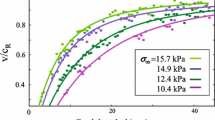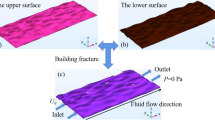Abstract
The transition from very smooth “mirror” crack growth to the early stages of roughening associated with “mist” has been investigated using a range of surface topography techniques. The fracture mechanics properties of the brittle, glassy and isotropic epoxy resin used in this work were characterized using compact tension (CT) and double torsion (DT) tests (K Ic=0.65 MN m−3/2). In the DT test, the mist to mirror transition occurred over a large section of the test sample and this facilitated examination by optical microscopy, scanning electron microscopy, atomic force microscopy and non-contact laser profilometry. Measurements on Wallner lines and river lines were used to map the crack velocities and directions over the fracture surface. The transition from mist to mirror, for a decelerating crack, occurred at a crack velocity, v c=0.1 v t, where v t is the shear wave velocity. There was a sharp change in roughness at the transition but no discontinuity in the crack deceleration behaviour. Two main topographical features were observed at the transition: firstly, undulations in the mirror region which decreased in amplitude away from the transition for a decelerating crack and, by implication, vice versa; secondly, a progressive decrease in river line density (for a decelerating crack). Detailed atomic force microscope profilometry was used to determine the surface topography associated with these features. The results provide an insight into the development of crack instabilities under dynamic conditions and a basis for interpreting the progressive development of roughness up to macroscopic bifurcation.
Similar content being viewed by others
References
W. J. Johnson and D. G. Holloway, Philos. Mag. 14 (1966) 731.
R. W. Rice, in “Fractography of Metal and Ceramic Failures”, ASTM STP 827, edited by J. J. Mecholsky and S. R. Powell (American Society for Testing and Materials, Philadelphia, PA, 1984) pp. 5–103.
B. R. Lawn, “Fracture of Brittle Solids”, 2nd Edn (Cambridge University Press, Cambridge, 1993).
D. Bahat, “Tectonofractography” (Springer, Berlin, 1991).
H. P. Kirchner and J. W. Kirchner, J. Am. Ceram. Soc. 62 (1979) 198.
H. P. Kirchner and J. C. Conway, ibid.— 70 (1987) 413.
Idem, ibid.,70 (1987) 419.
D. K. Shetty, G. K. Bansal, A. R. Rosenfield and W. H. Duckworth, ibid.— 63 (1983) 106.
D. Hull and P. Beardmore, in “Proceedings of the First International Conference of Fracture”, edited by T. Yokobori, T. Kawasaki and J. L. Swedlow (Japan Society for Strength and Fracture of Materials, Sendai, 1966) Vol. 2, pp. 629–45.
Y. L. Tsai and J. J. Mecholsky, Int. J. Fract. 57 (1992) 167.
A. S. Kobayashi, B. G. Wade, in “Deformation and fracture of high polymers,” edited by H. H. Kausch, J. A. Hassell and R. I. Jaffee (Plenum Press, New York, London, 1973) pp. 487–500.
J. W. Dally, W. L. Fourney and G. R. Irwin, Int. J. Fract. 27 (1985) 159.
J. F. Kalthoff, ibid.— 27 (1985) 277.
K. Ravi-Chandar and W. G. Knauss, ibid.— 25 (1984) 247.
Idem, ibid.,26 (1984) 65.
Idem, ibid.,26 (1984) 141.
Idem, ibid.,26 (1984) 189.
K. Takahashi and K. Arakawa, Exp. Mech. 44 (1987) 195.
K. Arakawa and K. Takahashi, Int. J. Fract. 48 (1991) 103.
J. E. Field, Contemp. Phys. 12 (1971) 1.
J. Congleton and N. J. Petch, Philos. Mag. 16 (1967) 749.
E. H. Yoffe, ibid.— 42 (1951) 739.
L. B. Freund, “Dynamic fracture mechanics” (Cambridge University Press, Cambridge, 1990).
W. J. Johnson and D. G. Holloway, Philos. Mag. 17 (1968) 899.
D. Hull, (1996) in preparation.
Idem,, Int. J. Fract. 66 (1994) 295.
A. J. Kinloch, S. J. Shaw, D. A. Tod and D. L. Hunston, Polymer 24 (1983) 1341.
“Annual ASTM Standards” (ASTM, Philadelphia, PA 1983) pp. 686–710.
P. S. Leevers, J. Mater. Sci. 17 (1982) 2469.
B. Stalder and H. H. Kausch, ibid.— 17 (1982) 2481.
S. Yamini and R. J. Young, Polymer 18 (1977) 1075.
D. Hull, Int. J. Fract. 62 (1993) 119.
H. Wallner, Z. Phys. 114 (1939) 368.
A. Smekal, Glastechn. Ber. 23 (1950) 57.
J. H. Greenwood, J. Mater. Sci. 6 (1971) 390.
E. Sommer, Eng. Fract. Mech. 1 (1969) 539.
D. Hull, Int. J. Fract. 70 (1995) 59.
Z. V. Djordjevic, X. Feng Li, W. S. Shim, S. L. Wunder and G. R. Baran, J. Mater. Sci. 30 (1995) 2968.
D. Hull, J. Mater. Sci. Lett. (1996) accepted.
C. De Freminville, Rev. Metall. 11 (1914) 971.
J. R. Rice, Y. Ben-Zion and K.-S. Kim, J. Mech. Phys. Solids 42 (1994) 813.
Author information
Authors and Affiliations
Additional information
Emeritus Goldsmiths' Professor of Metallurgy, University of Cambridge, UK.
Rights and permissions
About this article
Cite this article
Hull, D. Influence of stress intensity and crack speed on fracture surface topography: mirror to mist transition. Journal of Materials Science 31, 1829–1841 (1996). https://doi.org/10.1007/BF00372198
Received:
Accepted:
Published:
Issue Date:
DOI: https://doi.org/10.1007/BF00372198




